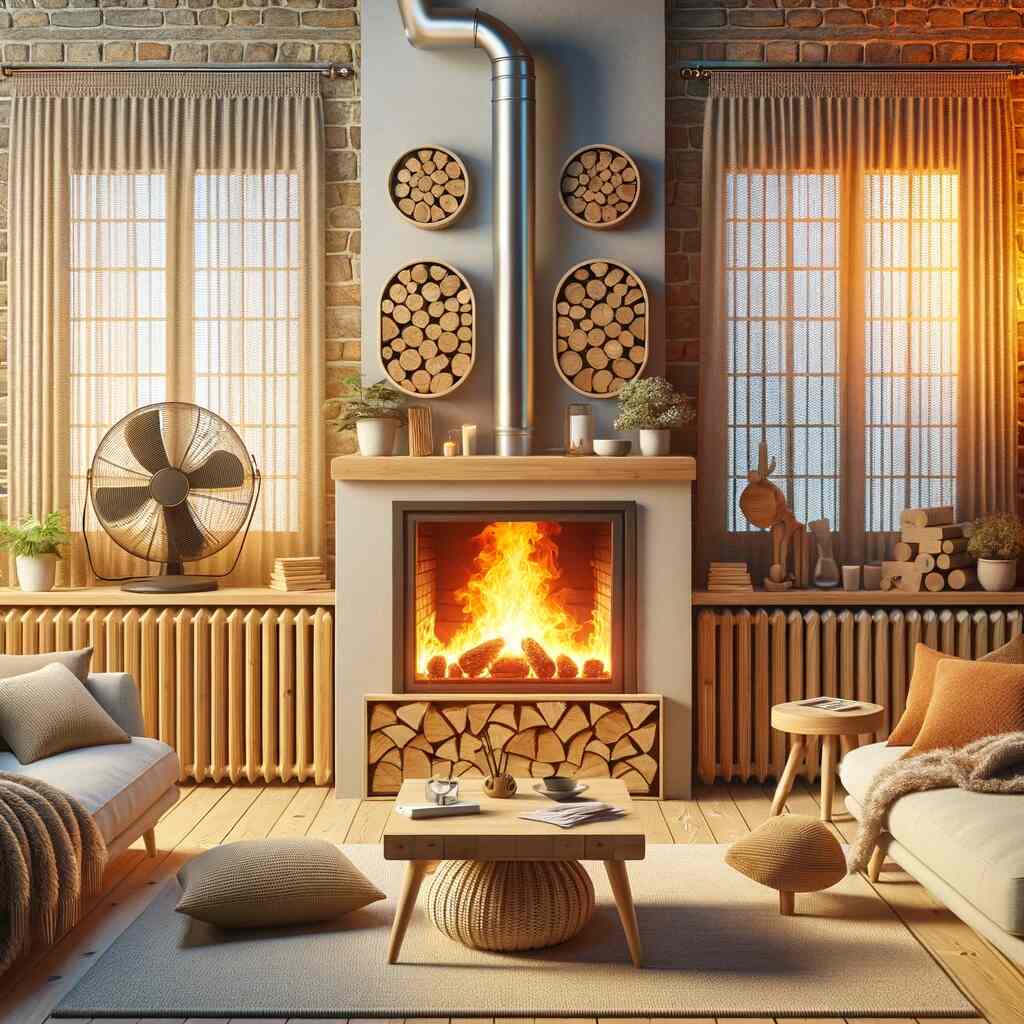Heating your home with firewood can be a cost-effective and environmentally friendly way to stay warm during the colder months. However, to make the most of your firewood and ensure efficient heat distribution, you need to employ the right techniques and equipment.
In this comprehensive guide, we’ll explore various strategies to optimize heat distribution from firewood in your home, helping you maximize comfort and minimize waste.
Understanding the Basics of Heat Distribution
Before diving into specific strategies, it’s essential to grasp the fundamental principles of heat distribution. When you burn firewood in a fireplace or wood-burning stove, the heat generated radiates outwards in all directions. To ensure even distribution throughout your home, you’ll need to consider factors such as convection, radiation, insulation, and airflow.
1. Choosing the Right Firewood
The type of firewood you use plays a significant role in determining how efficiently heat is distributed. Hardwoods like oak, hickory, and maple tend to burn longer and produce more heat than softwoods like pine or cedar. This is because hardwoods have a higher energy density and lower moisture content.
Ideally, you should aim for seasoned firewood, which has been properly dried for at least six months to a year. Seasoned wood burns more efficiently and produces less creosote, reducing the risk of chimney fires. Moisture content below 20% is generally considered ideal for seasoned firewood.
2. Efficient Fireplace or Stove Design
If you’re using a fireplace or wood-burning stove, consider the design of the unit itself. A well-designed fireplace or stove will maximize heat output while minimizing heat loss. Look for models with features like secondary combustion chambers, heat exchangers, and adjustable airflow controls.
Secondary combustion chambers allow for more complete burning of wood, which increases heat output and reduces emissions. Heat exchangers transfer heat from the combustion gases to the air, improving the overall efficiency of the unit. Adjustable airflow controls let you fine-tune the combustion process to maintain a steady and efficient burn.
3. Positioning and Insulation
Proper placement and insulation of your fireplace or stove are crucial for effective heat distribution. Here are some key tips:
- Central Location: Place your fireplace or stove in a central location within your home to ensure that heat is distributed evenly throughout the living spaces.
- Chimney Insulation: Make sure your chimney is properly insulated to prevent heat loss. Insulating the chimney can help maintain a strong draft, ensuring efficient combustion and heat distribution.
- Sealing Gaps: Seal any gaps or cracks around the fireplace or stove to prevent warm indoor air from escaping and cold outdoor air from entering. Use high-temperature caulk or gaskets designed for wood-burning appliances.
4. Using Fans and Heat Reclaimers
To improve heat distribution, consider using fans and heat reclaimers. These devices help circulate warm air more effectively and capture heat that would otherwise be lost.
- Heat Reclaimers: Heat reclaimers, also known as heat exchangers or radiator fans, are installed in the flue pipe or chimney of a wood-burning stove. They capture heat from the flue gases and circulate it into the room using a fan. This can significantly increase the overall efficiency of your heating system.
- Ceiling Fans: In rooms with high ceilings, ceiling fans can help distribute warm air more evenly. By running your ceiling fan in reverse (clockwise), you can push warm air down from the ceiling and into the living space.

Maximizing Heat Distribution with Firewood
Now that you have a solid understanding of the fundamentals, let’s delve into specific strategies to optimize heat distribution when using firewood for heating.
5. Proper Firewood Preparation
Before you even start the fire, proper firewood preparation is key to efficient heat distribution. Here’s what you need to do:
- Splitting Wood: Ensure that your firewood is split into appropriately sized pieces. Smaller logs and kindling ignite more easily and can help establish a strong fire quickly.
- Stacking Firewood: Store your firewood off the ground and in a well-ventilated area to prevent moisture buildup. A raised firewood rack or platform is ideal for this purpose.
- Storing Firewood: Always keep a supply of seasoned firewood close to your fireplace or stove for convenience. This minimizes the need to venture outdoors in cold weather to retrieve more wood.
6. Loading the Fireplace or Stove Efficiently
How you load your fireplace or stove can significantly impact heat distribution. Follow these guidelines for efficient loading:
- Layering: Start with a base layer of small kindling or newspaper, followed by larger pieces of firewood. Add more wood gradually as the fire burns to maintain a consistent heat output.
- Avoid Overloading: Don’t overload the fireplace or stove with too much wood at once. Overloading can lead to incomplete combustion and reduced efficiency.
- Airflow: Maintain proper airflow by leaving enough space between pieces of firewood. This allows oxygen to reach the fire, promoting complete combustion.
7. Using a Catalytic Converter (If Applicable)
Some modern wood-burning stoves come equipped with catalytic converters. These devices increase the efficiency of combustion by lowering the ignition temperature of gases, ensuring more complete combustion. If your stove has a catalytic converter, follow the manufacturer’s instructions for its use and maintenance to optimize heat distribution.
8. Regular Maintenance and Cleaning
To maintain efficient heat distribution, it’s essential to perform regular maintenance and cleaning of your fireplace or wood-burning stove:
- Chimney Cleaning: Have your chimney professionally cleaned at least once a year to remove creosote buildup, which can obstruct airflow and increase the risk of chimney fires.
- Ash Removal: Regularly remove ash from the firebox to maintain proper airflow and combustion efficiency. However, leave a small layer of ash (about an inch) to act as insulation.
- Inspect Gaskets and Seals: Check and replace gaskets and seals as needed to prevent air leaks around the stove or fireplace.
9. Optimizing Airflow
Airflow control is crucial for efficient heat distribution. Here’s how to optimize it:
- Primary Air: Most wood-burning appliances have a primary air control that regulates the amount of oxygen entering the firebox. Use it to establish the initial burn and control the fire’s intensity.
- Secondary Air: Secondary air controls, if available, introduce additional oxygen into the fire at a higher point in the combustion chamber. This promotes more complete combustion and reduces emissions.
- Dampers: Some stoves have dampers that control the flow of air through the stovepipe or chimney. Adjusting the damper can help regulate the burn rate and heat output.
10. Using Thermal Mass
Thermal mass refers to materials that can absorb and store heat. By incorporating thermal mass elements into your home design, you can improve heat distribution and retention. Here are a few ways to use thermal mass effectively:
- Masonry Heaters: Masonry heaters are designed to store and gradually release heat. They consist of a large, solid masonry mass that absorbs heat during the burn cycle and radiates it slowly into the room for hours or even days. While they require professional installation, they are incredibly efficient and provide excellent heat distribution.
- Tile or Stone Floors: If you have tile or stone floors, they can act as thermal mass to help distribute and retain heat. The floors will absorb heat when the fire is burning and release it slowly over time.
- Brick or Stone Walls: Incorporating brick or stone walls into your home’s design can also serve as thermal mass. These walls can absorb and radiate heat, improving overall comfort.
11. Zone Heating
Zone heating involves focusing the heat from your wood-burning appliance in specific areas of your home where you spend the most time. This approach can be especially useful for larger homes or homes with open floor plans. By concentrating heat in the most frequently used rooms, you can reduce the need to heat the entire house.
- Use Fans and Ducts: Install fans and ducts to direct warm air from the wood-burning appliance to other parts of the house.
- Close Doors: Keep doors closed to rooms that are not in use to prevent heat from escaping into unused areas.
- Install Thermostats: Consider installing thermostats in different zones of your home to control the temperature independently in each area.
- Space Heaters: Use energy-efficient space heaters in bedrooms or other rooms where you need extra warmth without heating the entire house.
12. Consider a Heat Distribution System
If you want a more sophisticated approach to heat distribution, you can invest in a dedicated heat distribution system. These systems use fans or ducts to circulate warm air throughout your home, ensuring even heating. Here are two common options:
- Forced Air Systems: Some wood-burning appliances are designed to work with forced air systems. These systems use fans to distribute warm air through ducts to various rooms in your home.
- Hydronic Systems: Hydronic heating systems use hot water or steam generated by your wood-burning appliance to heat your home. This can be an efficient and even more comfortable option for heat distribution.
Safety and Environmental Considerations
While optimizing heat distribution from firewood is essential for comfort and efficiency, it’s equally important to prioritize safety and environmental responsibility. Here are some key considerations:
13. Carbon Monoxide Monitoring
Always install carbon monoxide (CO) detectors in your home, especially if you’re using a wood-burning appliance. CO is a colorless, odorless gas that can be produced during incomplete combustion and poses a severe health hazard. Regularly test and replace CO detectors as needed to ensure they are functioning correctly.
14. Environmental Responsibility
To minimize your environmental impact, follow these guidelines:
- Burn Dry, Seasoned Wood: Burning wet or green wood produces more emissions and reduces efficiency. Stick to dry, seasoned firewood with low moisture content.
- Avoid Burning Treated Wood: Never burn wood that has been treated, painted, or stained. These materials can release harmful chemicals when burned.
- Respect Local Regulations: Be aware of local regulations and restrictions on wood-burning appliances and emissions. Some areas have specific rules to reduce air pollution.
15. Fire Safety Precautions
Fire safety should always be a top priority when using firewood for heating. Follow these precautions:
- Install a Spark Arrestor: If you have an open fireplace, consider installing a spark arrestor on your chimney to prevent embers from escaping and potentially causing a fire.
- Use a Fire Screen: When burning wood in an open fireplace, use a fire screen to prevent sparks and embers from popping out and onto your floor or furnishings.
- Keep Flammable Materials Away: Ensure that flammable materials such as curtains, furniture, and decorations are kept at a safe distance from the fireplace or stove.
Conclusion
Optimizing heat distribution from firewood in your home is not only about staying warm but also about reducing waste and environmental impact. By choosing the right firewood, using efficient appliances, employing proper techniques, and considering heat distribution strategies, you can create a comfortable and eco-friendly heating system.
Remember to prioritize safety and maintenance to enjoy the benefits of wood heating safely and sustainably. With the right approach, you can make the most of your firewood and keep your home cozy all winter long.





